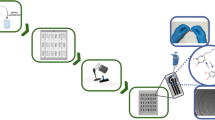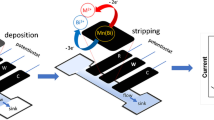Abstract
Two types of mass-produced, screen-printed carbon ink-based macrodisc electrodes suitable for routine sensing applications have been fabricated. Microscopic examination of these carbon ink electrode surfaces reveals that their surfaces are both rough and highly heterogeneous, consisting of random arrays of carbon particles of different sizes, as well as binder. Consequently, they may suffer from a lack of reproducibility in their performance because of variable resistance, capacitance or electroactive area. Use of a Fourier transform AC voltammetric protocol involving application of periodic waveform obtained from summation of five sine waves of variable frequency enabled resistance and capacitance, as well as DC and AC Faradaic currents associated with the model processes \({\text{FcMeOH}} \rightleftarrows {\text{FcMeOH}}^{\text{ + }} + {\text{e}}^ - \) or \(\left[ {Ru\left( {NH_3 } \right)_6 } \right]^{3 + } + e^ - \rightleftarrows \left[ {Ru\left( {NH_3 } \right)_6 } \right]^{2 + } \) (where FcMeOH is ferrocene methanol) to be assessed from a single experiment. Such data, which may be obtained rapidly via this approach, are highly suitable for quality control assessment.










Similar content being viewed by others
References
Galan-Vidal CA, Munoz J, Dominguez C, Alegret S (1995) TrAC Trends Anal Chem 14:225–231
Wang J (2002) TrAC Trends Anal Chem 21:226–232
Hart JP, Wring SA (1994) Electroanalysis 6:617–624
Hart JP, Crew A, Crouch E, Honeychurch KC, Pemberton RM (2004) Anal Lett 37:789–830
Green MJ, Hilditch PI (1991) Anal Proc (London) 28:374–376
Bond AM, Duffy N, Guo S-X, Zhang J, Elton D (2005) Anal Chem 77:186A–195A
Zhang J, Guo S-X, Bond AM, Marken F (2004) Anal Chem 76:3619–3629
Retter U, Lohse H (2002) In: Scholz F (ed) Electroanalytical methods: guide to experiments and applications. Springer, Berlin Heidelberg New York, pp 149–166
Bagotsky VS (2006) Fundamentals of electrochemistry. Wiley, Hoboken
Gileadi E (1993) Electrode kinetics for chemists, chemical engineering, and materials scientists. VCH, New York
Bard AJ, Faulkner LR (2001) Electrochemical methods. Wiley, New York
Pettit CM, Goonetilleke PC, Roy D (2006) J Electroanal Chem 589:219–231
Wang J, Tian B, Nascimento VB, Angnes L (1998) Electrochim Acta 43:3459–3465
Noh MFM, Kadara RO, Tothill IE (2005) Anal Bioanal Chem 382:1175–1186
Seddon BJ, Osborne MD, Lagger G, Dryfe RAW, Loyall U, Schaefer H, Girault HH (1997) Electrochim Acta 42:1883–1894
Osborne MD, Seddon BJ, Dryfe RAW, Lagger G, Loyal U, Schifer H, Girault HH (1996) J Electroanal Chem 417:5–15
Gilleo K (1996) Polymer thick film. Springer, Berlin Heidelberg New York
Sher AA, Bond AM, Gavaghan DJ, Gillow K, Duffy NW, Guo S-X, Zhang J (2005) Electroanalysis 17:1450–1462
Gavaghan DJ, Bond AM (2000) J. Electroanal Chem 480:133–149
Gavaghan DJ, Elton D, Bond AM (2001) Collect Czech Chem Commun 66:255–275
Zhang J, Bond AM (2007) J Electroanal Chem 600:23–34
Anicet N, Bourdillon C, Moiroux J, Saveant JM (1998) J Phys Chem B 102:9844–9849
Author information
Authors and Affiliations
Corresponding author
Appendix
Appendix
Derivation of the equations to calculate resistance and capacitance values
To use the FT AC voltammetric approach for quality control purposes, it was assumed that R u and C values of SPEs could be derived from the data obtained in a potential region where there is no Faradaic current and use of the simplest possible equivalent circuit (Fig. 3), where resistor (R s) and capacitor (C) are connected in series. It is noteworthy that R s is not necessarily equal to R u and should be used only as an approximation of the R u value. Nevertheless, easily acquired R s values are appropriate for quality control purposes. Under assumptions detailed in references [9–12], for each of the frequency components applied during an FT AC voltammetric experiment, admittance (Y) [magnitude (|Y|) and angle (∠Y)] values may be calculated from relationships developed in Eqs. 6a–15f.
For the fundamental harmonic of a given perturbation frequency (ω), the current (I) and voltage (V) with amplitude (A and B) and phase (φ and γ) exhibit the general time (t)-dependant relationships:
The current and voltage are then multiplied by sin(ω t) and cos(ω t), resulting in the following four components:
The high-frequency components (2ωt terms) are removed using a FT low-pass filter, resulting in real and imaginary current and voltage terms:
These equations can be rewritten in the form:
Admittance (Y) is calculated by combining Eqs. 9a and 9b:
Magnitude (|Y|) and angle components (∠Y) of admittance can then be directly determined as:
At a specific time, these terms are then used to obtain R s and C values directly from Eqs. 13 and 14:
In this equation, C is the symbol that is used to represent total capacitance, which is assumed to be derived primarily from the double layer capacitance (C dl), but may include contributions from other instrumental and stray terms, R s is the resistance which is assumed to be in series to the capacitor.
Equations 13 and 14 were derived from analysis of the impedance (Z) of the equivalent circuit shown in Fig. 3, which gives the relationship summarised in Eqs. 15a–f:
The derivations are equivalent to those widely available in standard textbooks on electrochemistry [9–11]. It is, of course, recognised that carbon electrodes are actually complex, chemically modified electrodes (see text) and that the simple RC network used for the equivalent circuit analysis represents only a modest approximation of the actual situation. A theoretical description of more complex equivalent circuits is available [12]. However, in quality control, it is the reproducibility of the data rather than absolute values of resistance and capacitance that is critical, and so, the simple RC approach was adopted.
Rights and permissions
About this article
Cite this article
Harris, A.R., Zhang, J., Konash, A. et al. Efficient strategy for quality control of screen-printed carbon ink disposable sensor electrodes based on simultaneous evaluation of resistance, capacitance and Faradaic current by Fourier transform AC voltammetry. J Solid State Electrochem 12, 1301–1315 (2008). https://doi.org/10.1007/s10008-008-0524-4
Received:
Revised:
Accepted:
Published:
Issue Date:
DOI: https://doi.org/10.1007/s10008-008-0524-4




